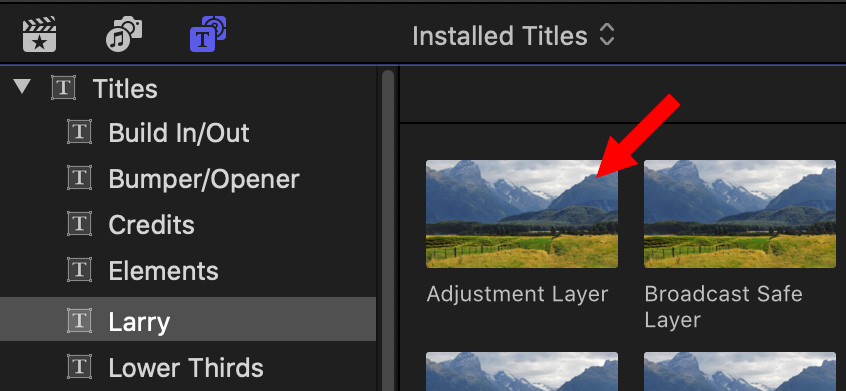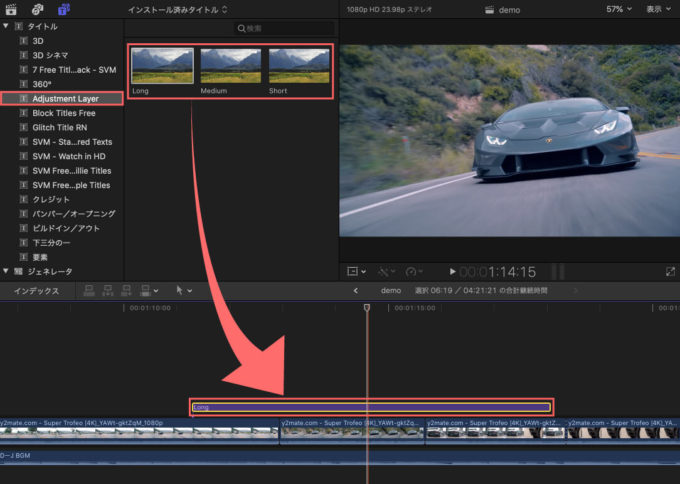
ADJUSTMENT LAYER FINAL CUT PRO X HOW TO
Please see PDF #1 in your download pack, this clearly identifies where you need to install your new plugin. If you are unfamiliar with how to install FCPX plugins, then PDF #2 has step by step instructions on how to locate or create the correct folders.
ADJUSTMENT LAYER FINAL CUT PRO X PRO
One thing is clear, though: if you want the power of the mocha planar tracker, the familiarity of the Final Cut Pro X interface and some powerful effects as well as customisation controls, SliceX is a killer app and it's inexpensive too at €115.75.Please watch the short tutorial above to see a step by step guide on how to download and install our plugins. Just as with mocha Pro, in the end it's how much time and effort you put into the compositing or rotoscoping that determines whether you'll end up with an effect that looks natural. In use, SliceX is really simple, which is not to say it's not time-intensive to create a well-defined and accurately tracked mask. SliceX has the added benefit of providing instant gratification when you want to blur areas, colour correct a shape on the move, create a vignette, or even add an accurate and highly customisable "bokeh" effect. In short, working with SliceX is as much fun as with mocha Pro. Of course, lens correction and some of the other high-end capabilities you'll find in mocha Pro aren't available in SliceX - I guess it wouldn't make much sense to have these in the Final Cut Pro X environment, either. Having said that, SliceX does support the same freeform drawing modes as mocha Pro (Bezier and X-spline) and allows you to use the tracked shapes of the Blank Adjustment Layer for any effect, not just for its own preset effects like blurring or removing objects.

SliceX obviously doesn't export to anything and only works with shapes. The similarities end there, as mocha Pro enables you to export rotoscoping/tracking data as well as mask shapes to a plethora of third party applications. That means you can set the tracker to "Perspective" or "Translate/Scale/Rotate" and to a quality of medium or high. You even get the same control over the tracking engine as in mocha Pro. Then you draw your shape and track backwards and forwards. showing the plane to track as cleanly as possible. You first select the best frame in a clip, e.g. That turned out to be a good idea as SliceX almost one-on-one works the same as mocha Pro. I was already more or less familiar with mocha Pro's tracking workflow, so I used my knowledge with SliceX. Finally, playback should be set to "Use Original" or "Optimized Media" for best results. Otherwise you risk background rendering to start while SliceX is still working.Īlso best is to turn off stabilisation.

The first thing you'll have to do to make SliceX work well is turn off background rendering. The adjustment layer comes in three versions: a blank one, a Shape Mask Border and a Vignette Shape Adjustment. The presets include Shape Mask, Object Remover, Blur Shape Mask, Color Correct Shape Mask, Depth of Field Shape Mask and Vignette Shape Mask. It lives in the Inspector with some five preset compositing effects, including one adjustment layer. You also get the ability to create shapes in freeform manner, just like what you're used to in mocha Pro.

You get the tracking power from mocha with the SliceX preset shapes. SliceX "powered by mocha" now makes SliceX the best since - heh - sliced bread. This meant that with every move of the shape you're trying to rotoscope or turn into a mask, you needed to create a keyframe. CoreMelt solved that problem by embedding the mocha tracking engine in their SliceX product.ĬoreMelt's SliceX originally was a keyframe based tracker. But it lacks a direct integration with Final Cut Pro X or even the latest version of Motion. It has won awards (even Oscars were involved) and it offers a complete environment for rotoscoping and compositing artists to work their magic. Mocha Pro is a great rotoscoping and masking tool for video.


 0 kommentar(er)
0 kommentar(er)
